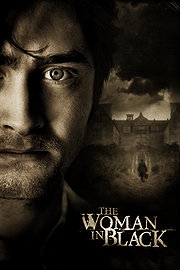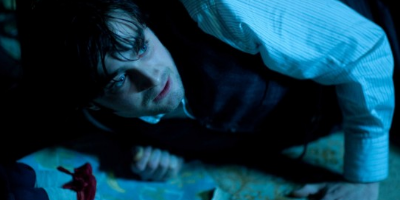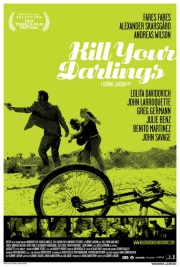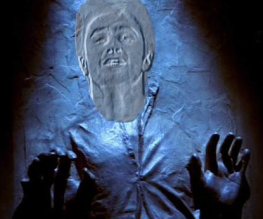The Woman In Black

One small criticism of The Woman In Black before I start being all nice about it: people casting Daniel Radcliffe in the future – if you want to steer your audience away from the invariable Potter comparisons, please don’t make your opening shot of him one where he’s on a speeding steam train. Especially not with him looking as though he has the weight of the (wizarding) world on his shoulders. It’s difficult enough to fight against thoughts of “back to school then, Harry?” without bellowing steam and a tortured expression to sweep us into Volde-duelling past. Ah well.
Based on a 1983 novel by Susan Hill, The Woman In Black is a deliciously traditional ghost story set in a deliciously traditional 19th century England. Arthur Kipps (Radcliffe) is still mourning the death of his young wife when he’s told in no uncertain terms by the solicitors he works for that he’s got one more chance to prove himself: an assignment in the small village of Crythin Gifford. A woman named Alice Drablow has passed away, and it’s up to Arthur to investigate the house, oversee the selling of the place and, in the great tradition of Vague Gothic Plot Devices, ‘go through all her papers’. Kissing his son goodbye, he boards the Hogwarts Exp train and it isn’t long before he’s decidedly unwelcomed by a village of dark-eyed, wary inhabitants. Every mention of his destination seems to cause fear, anger, and wobbly-lipped horror – and it’s only thanks to the friendly face of local man Mr Daily (Ciarán Hinds) that Kipps makes it onto the marshy road to the house at all.
Whispers of a malevolent spirit, a woman long dead and out for revenge draw in on Kipps thicker than the approaching fog, and by the time he’s finally trapped at Eel Marsh House with only a few candles, dark corridors and a rumours of a child-killing ghost for company, it’s clear that we’re not going to be in for a cosy evening.
In an age that seems to archly complicate every tale of the supernatural with “ITS ALL IN THE MIND, OR IS IT OH GOSH WE JUST DON’T-” preamble, it’s genuinely refreshing to watch a gothic story that wears its dark forces on its eerily fluttering sleeve. The Woman In Black is a ghost story, plain and simple – you’ve got your stormy nights, your imposing castle, your creaking floorboards and your jangling, juxtaposed wind-up toys, you’ve got your candlelight and you’ve got your ALL OF A SUDDEN THERE’S A THERE’S A OH MY oh wait it’s a crow. It might not be the most original story in the world, but settling down into the dark, dusty tropes and classic conventions of horror only heightens the enjoyment of Susan Hill’s traditional tale – noticeably tweaked for the tenser by Jane Goldman.
Director James Watkins confidently steers us through set piece after set piece with an innate sense of when to shock us, when to tease us and when to let the tension hang, resulting in an expertly crafted chiller that is all the more enjoyable for its knowing indulgence in the genre. Goldman does well to widen the narrative to include characters outside the imposing house, creating a tale of not only personal vengeance, but its affect on a doomed village and its families. The change makes the story feel justifiably cinematic; no mean feat considering the mega-success of the two-man theatrical adaptation.
Don’t get me wrong, The Woman In Black is not a perfect film. At times the air of gothic melodrama is at odds with the fairly naturalistic dialogue, with Radcliffe’s trademark stilted earnestness threatening to derail the tension altogether. The ending too feels a little anticlimactic after such a adrenaline-filled ride, with the final reveal of the woman herself never really hoping to live up to the horrors that lurk in our imaginations. If there is a critique to be made of James Watkins, is that he does more than he needs to – after dragging us through the teeth-crushingly tense walkways of Eel Marsh House, the unseen horrors he hints at in every frame are far more chilling than the triumphant shots of the fiend herself.
Still, these are but quibbles. It might be that the lead role should have gone to someone with a little more gravitas than Radcliffe, that the story falters in its ending moments and that at times the script tosses together an odd mix of knowing humour and earnest scare-mongering, but The Woman In Black is certainly a film that does its job. After all, when you have to remind yourself to keep your whimpering soundless whilst chanting ‘it’s only a 12, for God’s sake, it’s only a 12’ into your own hands, it can’t be denied that you’re watching a ghostly tale with solid punch.







Recent Comments